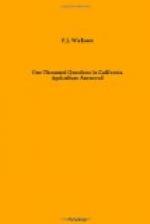Oats and Rust
Is there any variety of oats that is rust-proof, or any method of treating oats that will render them rust resistant? We are situated on a mountain, only about 12 miles from the coast, and have considerable foggy weather, which most of the farmers here say is the cause of the rust.
There is no way of treating oats which will prevent smut, if the variety is liable to it. There is a great difference in the resistance of different varieties. A few dark-colored oats are practically rust-proof, and you can get seed of them from the seedsmen in San Francisco and Los Angeles. Such varieties are chiefly grown on the southern coast. Foggy weather has much to do with the rust, because it causes atmospheric moisture which is favorable to the growth of the fungus, which is usually checked by dry heat, and yet there are atmospheric conditions occasionally which favor the rust even in the driest parts of the State. The fog favors rust, but does not cause it. The cause is a fungus, long ago thoroughly understood and named puccinia graminis.
Midsummer Hay Sowing.
Can I sow oats or barley in July upon irrigated mesa land, with the object of making hay in the fall? Which of the two would do the better in summer time? I have plenty of water.
We have never seen this done to advantage. If you desire to try it, irrigate thoroughly and plow and sow afterward. Use barley rather than oats and irrigate when the plant shades the land well, if you get growth enough to warrant it. It will be easier to get the crop than to figure a profit in it.
Loose Hay by Measure.
How many cubic feet should be allowed for a ton of alfalfa hay loaded on a wagon from the shock? I must sell more or less in that way, as no scales are near enough to be used.
It is a proposition, as to the weight of loose hay, which could of course keep changing the higher you built the load on the wagon. It is easier to give figures on weight from a stack in which there has been something like uniform pressure for a time. In the case from a 30-day stack it is common to allow an eight-foot cube to a ton, etc. Perhaps you can guess from that.
When to Cut Oat Hay.
To make the best red oat hay should it be cut when in the “milk,” “dough” or nearly ripe!
It should be cut in the “soft dough” or, as some express it, “between the milk and the dough.” This is probably as near an approach in words as can be made to that condition which loses neither by immaturity or by over-maturity from the point of view of hay which is to get as much as can be in the head without losing nutritiveness in the straw. Of course there are other conditions intruding sometimes, like the outbreak of rust or the premature ripening through drought. In such cases care must be taken not to let the plant stand too long for the sake of reaching an ideal condition in the head — which for lack of favorable growing conditions the plant may not be able to reach.




